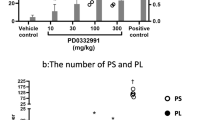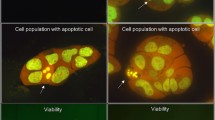Abstract
Purpose
This study analyzed the kinetics of in vivo micronucleus induction in normoblasts by determining the kinetics of difluorodeoxycytidine (dFdC)-induced micronucleated polychromatic erythrocytes (MN-PCEs) in the peripheral blood of mice. The kinetic indexes of MN-PCE induction of dFdC were correlated with the previously reported mechanisms DNA damage induction by this compound. In general, this study aimed to establish an in vivo approach for discerning the processes underlying micronucleus induction by antineoplastic agents or mutagens in general.
Methods
The frequencies of PCEs and MN-PCEs in the peripheral blood of mice were determined prior to treatment and after treatment using dFdC at doses of 95, 190, or 380 µmol/kg at 8 h intervals throughout a 72 h post-treatment.
Results
The area beneath the curve (ABC) for MN-PCE induction as a function of time, which is an index of the total effect, indicated that the dose response was directly proportional and that the effect of dFdC on micronucleus induction was reduced compared with that of aneuploidogens and monofunctional and bifunctional alkylating agents but increased compared with that of promutagens, which is consistent with our previous results. The ABC showed a single peak with a small broadness index, which indicates that dFdC has a single mechanism or concomitant mechanisms for inducing DNA breaks. The time of the relative maximal induction (T rmi) indicated that dFdC requires more time to achieve MN-PCE induction compared with aneugens and monofunctional and bifunctional alkylating agents, although it requires a similar time to achieve MN-PCE induction as azacytidine, which is consistent with evidence showing that both agents must be incorporated into DNA for their action to be realized. The timing of maximal cytotoxicity observed with the lowest dFdC dose was correlated with the timing of the main genotoxic effect. However, early and late cytotoxic effects were detected, and these effects were independent of the genotoxic response.
Conclusions
A correlation analysis indicated that dFdC appears to induce MN-PCEs through only one mechanism or mechanisms that occur concomitantly, which could be explained by the previously reported concurrent inhibitory effects of dFdC on DNA polymerase alpha, polymerase epsilon, and/or topoisomerase. The timing of maximal cytotoxicity was correlated with the timing of maximal genotoxicity; however, an early cytotoxic effect that appeared to occur prior to the incorporation of dFdC into DNA was likely related to a previously reported inhibitory effect of dFdC on thymidylate synthase and/or ribonucleotide reductase.






Similar content being viewed by others
References
Serdjebi C, Milano G, Ciccolini J (2015) Role of cytidine deaminase in toxicity and efficacy of nucleosidic analogs. Expert Opin Drug Met Toxicol 11:665–672.
Lawley PD, Phillips DH (1996) DNA adducts from chemotherapeutic agents. Mutation Res 355:13–40.
Parker PW (2009) Enzymology of purine and pyrimidine antimetabolites used in the treatment of cancer. Chem Rev 109:2880–2893
Crespan E, Garbelli A, Amoroso A, Maga G (2011) Exploiting the nucleotide substrate specificity of repair DNA polymerases to develop novel anticancer agents. Molecules 16:7994–8019
Li KK, Li F, Li QS, Yang K, ** B (2013) DNA methylation as a target of epigenetic therapeutics in cancer. Anticancer Agents Med Chem 13:242–247
Ferrara R, Pilotto S, Peretti U, Caccese M, Kinspergher S, Carbognin L, Karachaliou N, Rosell R, Tortora G, Bria E (2016) Tubulin inhibitors in non-small cell lung cancer: looking back and forward. Expert Opin Pharmacother 17:1113–1129
Lee JJ, Huang J, England CG, McNally LR, Hermann B, Frieboes HB (2013) Predictive modeling of in vivo response to gemcitabine in pancreatic cancer. PLoS One 9:e1003231.
Morales-Ramírez P, Vallarino-Kelly T, Anguiano-Orozco G, Rodríguez-Reyes R (1997) Pharmacokinetic parameters of genotoxic activity inferred by the comparison of the kinetics of MN-PCE induced by chemical agents and ionizing radiation. Mutation Res 391:127–134.
Morales-Ramírez P, Vallarino-Kelly T, Cruz-Vallejo V (2014) Kinetics of micronucleus induction and cytotoxicity caused by distinct antineoplastics and alkylating agents in vivo. Toxicol Lett 224:319–325
Armstrong MJ, Galloway SM (1997) Mismatch repair provokes chromosome aberrations in hamster cells treated with methylating agents or 6-thioguanine, but not with ethylating agents. Mutation Res 373:167–178.
Aydemir N, Bilaloglu R (2003) Genotoxicity of two anticancer drugs, gemcitabine and topotecan, in mouse bone marrow in vivo. Mutation Res 537:43–51.
Classen J, Paulsen F, Hehr T, Bamberg M, Budach W (2002) Effect of gemcitabine on acute and late radiation toxicity of skin and underlying soft tissues to single-dose irradiation in a nude mice model. Int J Radiat Oncol Biol Phys 53:197–205
Grégoire V, Beauduin M, Rosier JF, De Coster B, Bruniaux M, Octave-Prignot M, Scalliet P (1997) Kinetics of mouse jejunum radiosensitization by 2′,2′-difluorodeoxycytidine (gemcitabine) and its relationship with pharmacodynamics of DNA synthesis inhibition and cell cycle redistribution in crypt cells. Br J Cancer 76:1315–1321
Viveka S, Udyavar A, Shetty B, Kuriakose S, Sudha MJ (2015) Histomorphometric effects of gemcitabine on Swiss albino mice spermatogenesis. Adv Biomed Res 4:29–34
Schmid W (1975) The micronucleus. Mutation Res 31:9–15.
Morales-Ramírez P, Vallarino-Kelly T (1998) Pharmacokinetic parameters determined from the clastogenic activity of ethylnitrosourea (ENU) and dimethylnitrosamine (DMN) in mice in vivo. Mutation Res 412:315–322.
Erlichman C (1987) The pharmacology of anticancer drugs. In: Tannock IF, Hill RP (eds) The basic science of oncology. Pergamon Press, USA, pp 292–307
Braakhuis BJ, van Dongen GA, Vermorken JB, Snow GB (1991) Preclinical in vivo activity of 2,2-difluorodeoxycytidine (gemcitabine) against human head and neck cancer. Cancer Res 51:211–214
Grunewald R, Kantarjian H, Du M, Faucher K, Tarassoff P, Plunkett W (1992) Gemcitabine in leukemia: a phase I clinical, plasma, and cellular pharmacology study. J Clin Oncol 10:406–413
Noble S, Goa KL (1997) Gemcitabine. A review of its pharmacology and clinical potential in non-small cell lungcancer and pancreatic cancer. Drugs 54:447–472
Mackey JR, Mani RS, Seiner M, Mowles D, Young JD, Belt JA, Crawford CR, Cass CE (I998) Functional nucleoside transporters are required for gemcitabine influx and manifestation of toxicity in cancer cell lines. Cancer Res 58:4349–4357
Heinemann V, Xu YZ, Chubb S, Sen A, Hertel LW, Grindey GB, Plunkett W (1990) Inhibition of ribonucleotide reduction in CCRF-CEM cells by 2′,2′-difluorodeoxycytidine. Mol Pharmacol 38:567–572
Honeywell RJ, Ruiz van Haperen VW, Veerman G, Smid K, Peters GJ (2015) Inhibition of thymidylate synthase by 2′,2′-difluoro-2′-deoxycytidine (Gemcitabine) and its metabolite 2′,2′-difluoro-2′-deoxyuridine. Int J Biochem Cell Biol 60:73–81
Veltkamp SA, Pluim D, van Eijndhoven MAJ, Bolijn MJ, Ong FHG, Govindarajan R, Unadkat JD, Beijnen JH, Schellens JHM (2008) New insights into the pharmacology and cytotoxicity of gemcitabine and 2′,2′-difluorodeoxyuridine. Mol Cancer Ther 7:2415–2425
Huang P, Chubb S, Hertel LW, Grindey GB, Plunkett W (1991) Action of 2′,2′-difluorodeoxycytidine on DNA synthesis. Cancer Res 51:6110–6117
Pourquier P, Gioffre C, Kohlhagen G, Urasaki Y, Goldwasser F, Hertel LW, Yu S, Pon RT, Gmeiner WH, Pommier Y (2002) Gemcitabine (2′,2′-difluoro-2′-deoxycytidine), an antimetabolite that poisons topoisomerase I. Clin Cancer Res 8:2499–2504
Morales-Ramírez P, Vallarino-Kelly T, Cruz-Vallejo VL (2008) Mechanisms of DNA breaks induction in vivo by 5-azacytidine: paths of micronucleus induction by azaC. J Appl Toxicol 28:254–259
Santi DV, Norment A, Garret CE (1984) Covalent bond formation, between a DNA-cytosine methyltransferase and DNA containing 5-azacytosine. Proc Natl Acad Sci USA 81:6993–6997
Satoh T, Yamamoto K, Miura KF, Sofuni T (2004) Region-specific chromatin decondensation and micronucleus formation induced by 5-azacytidine in human TIG-7 cells. Cytogenet Genome Res 104:289–294
Tobey RA (1972) Effects of cytosine arabinoside, daunomycin, mithramycin, azacytidine, adriamycin, and camptothecin on mammalian cell cycle traverse. Cancer Res 32:2720–2725
Bouchard J, Momparler RL (1983) Incorporation of 5-aza-2′-deoxycytidine-5′-triphosphate into DNA. Interactions with mammalian DNA polymerase alpha and DNA methylase. Mol Pharmacol 24:109–114
Giovannetti E, Mey V, Loni L, Nannizzi S, Barsanti G, Savarino G, Ricciardi S, Del Tacca M, Danesi R (2007) Cytotoxic activity of gemcitabine and correlation with expression profile of drug-related genes in human lymphoid cells. Pharmacol Res 55:343–349
Brenet F, Kermani P, Spektor R, Rafii S, Scandura JM (2013) TGFβ restores hematopoietic homeostasis after myelosuppressive chemotherapy. J Exp Med 210:623–639
Auer H, Oehler R, Lindner R, Kowalski H, Sliutz G, Orel L, Kucera E, Simon MM, Glössl J (1997) Characterisation of genotoxic properties of 2′,2′-difluorodeoxycytidine. Mutation Res 393:165–173.
Donadelli M, Constanzo C, Beghelli S, Scupoli MT, Dandrea M, Bonora A, Piacentini P, Budillon A, Caraglia M, Scarpa A, Palmieri M (2007) Synergistic inhibition of pancreatic adenocarcinoma cell growth by trichostatin A and gemcitabine. Biochim Biophys Acta 1773:1095–1106.
Maehara S, Tanaka S, Shimada M, Shirabe K, Saito Y, Takahashi K, Maehara Y (2004) Selenoprotein P, as a predictor for evaluating gemcitabine resistance in human pancreatic cancer cells. Int J Cancer 112:184–189
Morales-Ramírez P, Vallarino-Kelly T, Rodríguez-Reyes R (1996) Effect of chlorophyllin on gamma ray induced micronuclei in polychromatic erythrocytes of murine peripheral blood determined by the ABC strategy. Mutation Res 367:51–56.
Perry P, Evans HJ (1975) Cytological detection of mutagen-carcinogen exposure by sister chromatid exchange. Nature 258:121–125
Abramsson-Zetterberg L, Grawé J, Zetterberg G (1995) Flow cytometric analysis of micronucleus induction in mice by internal exposure to 137Cs at very low dose rates. Int J Radiat Biol 67:29–36
Morales-Ramírez P, Vallarino-Kelly T, Cruz-Vallejo VL, López-Iturbe R, Alvaro-Delgadillo H (2004) In vivo kinetics of micronuclei induction by bifunctional alkylating antineoplastics. Mutagenesis 19:207–213
Acknowledgements
We would like to thank Angel Reyes and Perfecto Aguilar for providing excellent technical assistance.
Author information
Authors and Affiliations
Corresponding author
Ethics declarations
Animal welfare
The animals were treated and housed in accordance with the Guide for the Care and Use of Laboratory Animals, Commission on Life Sciences, Institute of Laboratory Animal Research, National Research Council (1996). The protocol was reviewed and approved by the Internal Committee of Care and Use of Laboratory Animals (CICUAL) that oversees the ethics of research involving the use and welfare of animals.
Funding
This work was supported by Project CB-507 from the Instituto Nacional de Investigaciones Nucleares (México) and Project 240116 from the Consejo Nacional de Ciencia y Tecnología (CONACYT) of México.
Rights and permissions
About this article
Cite this article
Morales-Ramírez, P., Vallarino-Kelly, T. & Cruz-Vallejo, V. Genotoxicity kinetics in murine normoblasts as an approach for the in vivo action of difluorodeoxycytidine. Cancer Chemother Pharmacol 79, 843–853 (2017). https://doi.org/10.1007/s00280-017-3290-0
Received:
Accepted:
Published:
Issue Date:
DOI: https://doi.org/10.1007/s00280-017-3290-0




